'A bright future for our country'
Sovereign Native Youth STEM Leadership Academy brings 18 students together in NebraskaBy Kevin Abourezk
@Kevin_Abourezk In a dusty workshop where 3-D printers, table saws and an autonomous car share space, a group of 18 Native high school students glued propellers, wires and motors together, trying to assemble small electronic devices. But before they could start their work, they listened to a young Oglala Sioux woman, Sydney James, instruct them on how to construct the remote controls. “The little wires are soldered onto the motors,” said James, a civil engineering student at the University of Nebraska-Lincoln. “They’re not on there very well so be careful. It is fragile, and if your motor comes off, it’s not going to work. You’re not going to have a good time.” Later, the students would attach the motorized propellers onto balloons filled with helium and use the remote control devices they constructed to guide the balloons through the air. The activity was part of a weeklong series of events designed to teach the 18 students about science, technology, engineering and mathematics. The eighth annual Sovereign Native Youth STEM Leadership Academy, which ended Friday, brought Native students to Lincoln, Nebraska to learn about careers in science.

The Nebraska Commission on Indian Affairs, Mid-America Transportation Center and the Nebraska Transportation Center hosted the academy. The students visited museums, a planetarium, a Native-owned architectural firm, the governor’s mansion (where they had lunch with Nebraska's first lady, Susanne Shore) and the state Capitol, where the state’s first Native state senator taught them about state government. They also listened to presentations by University of Nebraska engineering and medical professors and got to build boats and remote-control balloons. Larry Rilett, director of the Mid-America Transportation Center, said the academy is designed to educate the students about the many opportunities available to them in science, a field that few Native people even bother to explore. “We have an incredible shortage of technical people in technical jobs right now so there’s a lot of opportunity, and the reality is if we don’t get everyone involved we’re not going to be able to fill that demand,” Rilett said. “Having people from all different groups and cultures makes everything better for us when we’re talking about technology.”

The academy, which was free to the students, also introduced them to other fields, including education, government, the law, journalism and filmmaking. Only Native students from Nebraska were selected to participate this year, though Rillet said he would like to expand the academy to include students from South Dakota and Kansas in the future. Judi M. gaiashkibos, executive director of the Nebraska Commission on Indian Affairs, said the academy has continued to improve each year in educating Native students to become leaders. “Observing them restores my faith in the promise and resilience of our people,” she said. “I am confident that these young people will become the leaders and citizens of a bright future for our country.” Daunnette Moniz-Reyome, a 16-year-old Winnebago girl, said the camp taught her a lot about technology, science and engineering but also taught her about herself. And the academy’s staff never acted like their duties were work to them but instead seemed to enjoy getting to know the students and having fun with them. Moniz-Reyome said she also enjoyed getting to meet other Native students. “The girls I hung out with here at the camp live literally like 10 minutes away from me, and I didn’t know them,” she said. “Hopefully, since I met them and got to know them here, we’ll be able to take that relationship back with us.”
Students built DIY boats at UNL's Innovation Campus on Monday for the Nebraska Commission on Indian Affairs/MATC...
Posted by Mid-America Transportation Center (MATC) on Wednesday, June 27, 2018
Join the Conversation

